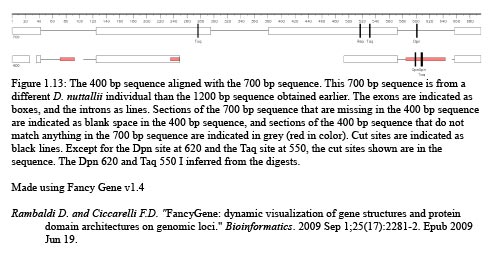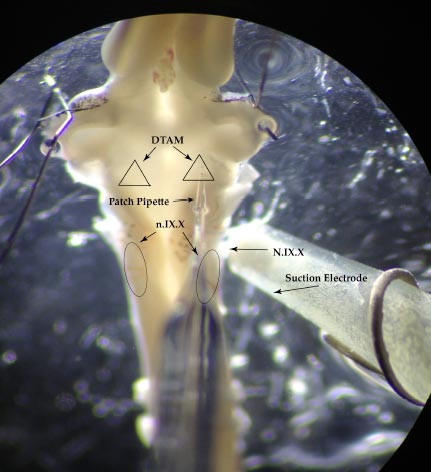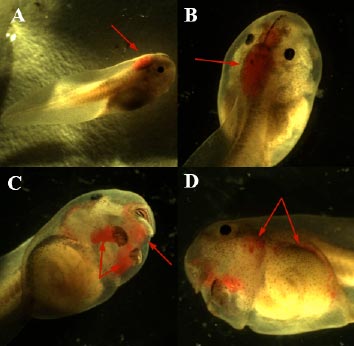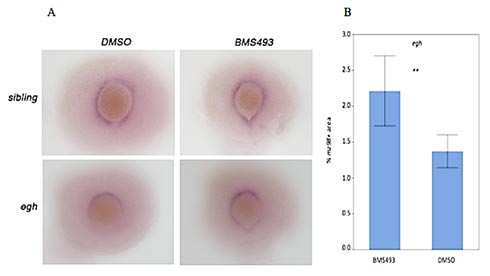2014 Senior Thesis Abstracts
(CLASS OF 2014: If your thesis abstract is not currently included on this page and you would like it to be, please follow this link.)
Nitrogen Fixation in the Biological Soil Crusts of Eastern Oregon
Scott Breitenstein
(Advisor: Dalton)
Biological soil crusts are communities of microorganisms, lichens, and bryophytes that form in the interspaces between vascular plants in arid environments across the globe. These crusts perform photosynthesis and nitrogen fixation, often constituting the primary source of organic nitrogen for these ecosystems. In Eastern Oregon, biological crusts are relatively uncharacterized, and their nitrogen-fixing properties are not well understood. In this study, an acetylene reduction assay was used to estimate nitrogen fixation in crusts from Eastern Oregon. In addition, TOPO cloning was used to identify crust community members based on their 16S rDNA and nifH gene sequences. Several taxa were identified, including the heterocystous nitrogen-fixing cyanobacteria Nostoc and Tolypothrix.
A Search for Nuclear Phylogeographic Markers in Delphinium Nuttallii
Ellen Rebecca Levkoy
(Advisor: Karoly)
In this study I sought to locate nuclear genetic molecular markers in the endemic Northwest wildflower Delphinium nuttallii for the ultimate purpose of detecting patterns of genetic variation that could give information about historical events. I searched Delphinium nuttallii genes of known sequence for intronic regions containing variation on a useful scale to be a nuclear molecular marker for phylogeographic analysis. I did this in part to compare nuclear phylogeography with an existing choroplast DNA data set. I selected a region of DFR to sample over seven populations along a westward and northward range expansion hypothesized to have occurred during the Pleistocene era. I found 13 unique haplotypes by restiction enzyme digest of a 700 bp DFR PCR product. Whereas chloroplast variation had decreased along the range expansion, nuclear data showed higher variation in the recent expansion and no variation in what was thought to be an ancentral population. These haplotpes did not resolve into a minimally homoplastic network. It seems likely that this difficulty constructing a network is partially due the large number of small insertion/deletion variations observed in the introns when viewed as sequence alignment. The presence of these indels also made difficult the choice of bin size to assign homologous cut sites when scoring digests. This feature makes DFR a poor candidate for a nuclear molecular marker. However, it reveals the challenges associated with producing nuclear genetic markers in a non-model species.

Searching for the neural rhythmogenesis of Xenopus laevis' vocal communication necessitates troubleshooting
Patrick Scott Sadil
(Advisor: Zornik)
Xenopus laevis brains produce advertisement-calling-like patterns upon application of serotonin. The production of this song can be monitored ex vivo. Rhythmogenesis of X. laevis' vocal communication occurs in the Fast Trill Neurons (FTNs) of the dorsal egmental area of the medulla (DTAM) in an NMDA dependent manner. However, the serotonin receptor subtype implicated in advertisement call initiation is not expressed in DTAM. So, how serotonin recruits the vocal circuity remains unclear.
I hypothesized that the voltage sensitivity of NMDA receptors enabled FTN oscillations, and that serotonin acts directly on FTNs (via their long, dendritic projections to the rostal region of the dorsal Raphe ́ nucleus) to facilitate this behavior. In this thesis, the activity of FTNs' response to both NMDA and serotonin—during their pharmacological isolation from the rest of the vocal network—was monitored via patch-clamp techniques.
Recordings support further division of FTNs into subpopulations based on differential roles in rhythmogenesis; while all FTNs seem capable of intrinsically generated membrane potential oscillations, perhaps only a few send dendrites to the Raphe ́. However, the majority of data manifested unintelligibly. Taken as a whole, this thesis serves primarily as an overview of troubleshooting neurophsyiological protocols that might aid further explorations into rhythmicity, neuronal signaling, and vocal communication as dealt with in Xenopus.

Characterization of Telomerase Products in Xenopus laevis Tissue Extracts
Erin Michelle Sheffels
(Advisor: Shampay)
Eukaryotes with linear chromosomes avoid the loss of critical sequences during DNA replication by including repeated DNA sequences called telomeres at chromosome ends. The enzyme telomerase is a reverse transcriptase that adds telomeric repeats to DNA. Telomerase activity can be measured in vitro by performing a TRAP assay. Earlier work has used TRAP assays to show that Xenopus laevis, the African clawed frog, has telomerase constitutively active in its adult somatic tissues. This thesis aims to determine the cause of the unexpectedly bright 74 bp band observed in the TRAP ladders produced by some Xenopus laevis tissue and cell culture extracts, which suggests an inhibition of telomerase processivity in those extracts. Mixing experiments between extracts with and without the brighter band show that the band intensity patterns are not due to preferential amplication of the 74 bp product during PCR. Mixing experiments also show that the relative abundance of the 74 bp telomerase extension product is not influenced by an abundant, diusible factor. Preliminary evidence suggests that the strength of the 74 bp band decreases relative to adjacent bands as telomerase activity drops in an extract that has been stored under suboptimal conditions, consistent with a protein factor being responsible for the band strength.
Female Sex Steroids Alter The Subcellular Localization of RANKL in MCF-7 Breast Cancer Cells
Molly Jane Spilka
(Advisor: McClellan)
Long-term use of combined estrogen and progesterone hormone replacement therapy is correlated to an increased risk of metastatic breast cancer. Recent research suggests that Receptor Activator of Nuclear Factor κB Ligand (RANKL) is involved in female sex steroid hormone-induced mammary gland proliferation and also may potentiate breast cancer metastasis to the bone. This study attempted to test whether RANKL is a paracrine mediator of progesterone-induced proliferation in MCF-7 breast cancer cells by examining the cellular and subcellular distribution of RANKL, Estrogen Receptors, Progesterone Receptors, and a marker of proliferation, Ki67, following treatment of estradiol (E2) and progesterone (P4) using immunocytochemistry. RANKL was unexpectedly localized to vesicles within the cytoplasm of all cells, regardless of treatment. Though steroid hormone treatment increased the number of cells in the proliferating pool, the role of RANKL in mediating this proliferation is unclear. However, RANKL-containing vesicles were trafficked from the perinuclear area to the plasma membrane following exposure to E2 or E2 + P4. Because membrane tethered RANKL signals bone remodeling, localization of RANKL to the plasma membrane of MCF-7 cells suggests its possible role in metastatic breast cancer.

Title: RANKL-containing vesicles are trafficked to the plasma membrane following steroid hormones treatment
Effects of the herbicide diuron on multiple life stages of Bombina orientalis: implications for pesticide use and amphibian conservation
Taylor Rose Stinchcomb
(Advisor: Kaplan)
Chemical contamination of the aquatic environment has been increasingly linked to amphibian population declines. As land is converted to agriculture, amphibians inhabit landscapes that are subjected to large-scale and non-targeted application of pesticides. Diuron (N-(3,4-dichlorophenyl)-N,N-dimethyl-urea) is a phenyl urea herbicide used heavily in the state of Oregon and the greater U.S. It is a suspected endocrine-disrupting compound, but very little is known about its effects in vertebrates. Using Bombina orientalis, the Oriental Fire-Bellied Toad, as a model species, this thesis sought to assess the susceptibility of amphibians to diuron and the specific character of its toxicity. The lethal and sublethal impacts of diuron on B. orientalis survival, growth, and development were investigated in a series of four experiments, involving embryonic, early larval, and tadpole life stages, as well as a transfer from adult female to oocyte. Exposure to diuron resulted in dose-dependent mortality, with significant death at the highest test concentration of 30 mg/L, and produced abnormalities of the circulatory system. Diuron impaired larval growth rates and delayed hind limb development in tadpoles, though little difference in the magnitude of these effects was observed between mid-range (22.5 mg/L) and low (15 mg/L) concentrations. Female diuron exposure was found to have a strong effect on offspring mortality rates, with high and environmentally-relevant diuron concentrations (125 µg/L) in the maternal environment increasing offspring susceptibility. This maternal transfer of toxicity and a direct hindrance of hind limb differentiation support the hypothesis that diuron interferes with endocrine activity. At concentrations above 15 mg/L, diuron is toxic to B. orientalis life stages that may be key for population regulation. Continued unabated and indiscriminant application of diuron poses a risk to amphibian life and may threaten human health.

Figure 18.Observations of posterior blood vessel reddening in experiment IV B. orientalis larvae. Cranial reddening (A, B) in the dorsal net of head (DNH) began at approximately the commencement of opercular folding (stage 23). Ventral reddening in the ventral and lateral lymph sacs (C) and along the anterior lymph heart (D) was observed late in opercular folding as tadpoles approached bilateral opercular closure (stage 25) and onwards.
Retinoic Acid Signaling and Retinal Stem Cell Behavior in the Zebrafish Ciliary Marginal Zone
Amanuel Melesse Tafessu
(Advisor: Cerveny)
A variety of signaling pathways regulate neural stem cell behavior in the vertebrate retina. Analysis of a recently isolated zebrafish mutant known as egghead (egh) suggests a role for retinoic acid (RA) signaling in promoting differentiation of retinal stem cells. The egh allele encodes a hypomorphic allele of the TGF-β – related growth and differentiation factor (Gdf)-6a. egh embryos exhibit small eyes, ventralized retinas with enhanced RA signaling and reduced expression of the stem cell marker mz98 in the ciliary marginal zone (CMZ), the stem cell niche of the neural retina. egh retinal stem and progenitor cells do not exhibit enhanced apoptosis, and treatment of wild type embryos with exogenous RA has previously been shown to mimic the egh CMZ phenotype. In this study, the expression of the retinal ganglion cell marker atoh7 in egh and sibling embryos was compared to determine whether precocious differentiation of retinal stem cells depletes the stem cell population of the egh CMZ. atoh7 mRNA was found to be more abundant in egh at 25 and 28 hours post-fertilization (hpf), suggesting that enhanced early differentiation occurs in the egh retina. To address the role of RA signaling in this process, the RA pathway was inhibited starting from 16 hpf. Treatment of egh embryos with the RA receptor antagonist BMS493 (15 µM) from 16 to 40 hpf partially restores the retinal stem cell population of the ventral retina by 60 hpf. Similarly, sibling embryos treated with BMS493 during the same period in addition to 16-28 hpf and 20-32 hpf display a ventral expansion of the mz98 expression domain, indicating that RA signaling promotes the transition from stem cell to progenitor cell in the zebrafish CMZ.

Figure 16. Inhibition of the RA pathway promotes stem cell maintenance in the CMZ. Lateral views of retinas from sibling (top) and egh (bottom) embryos treated with BMS493 (15 µM) from 16 to 40 hpf display ventral expansion of the stem cell marker mz98 (purple stain) by 60 hpf (A). The area occupied by mz98+ cells (B) in egh increases from 1.4(+/- 0.3)% in vehicle treated embryos to 2.2(+/-0.8)% of the total area of a single focal plane of the retina (p<0.01) Error bars indicate a 95% confidence interval.